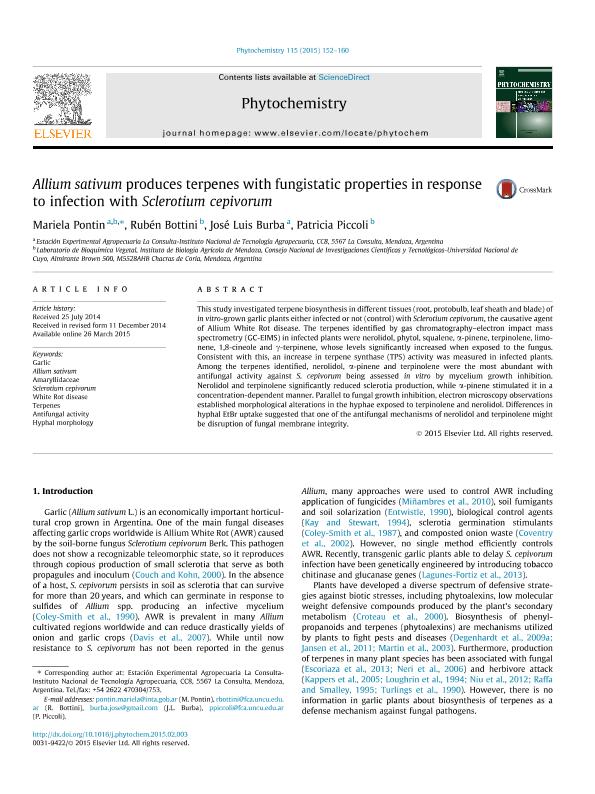Mostrar el registro sencillo del ítem
dc.contributor.author
Pontin, Mariela Ana

dc.contributor.author
Bottini, Ambrosio Rubén

dc.contributor.author
Burba, José Luis

dc.contributor.author
Piccoli, Patricia Noemí

dc.date.available
2017-08-15T12:22:02Z
dc.date.issued
2015-07-26
dc.identifier.citation
Pontin, Mariela Ana; Bottini, Ambrosio Rubén; Burba, José Luis; Piccoli, Patricia Noemí; Allium sativum produces terpenes with fungistatic properties in response to infection with Sclerotium cepivorum; Elsevier; Phytochemistry; 115; 26-7-2015; 152-160
dc.identifier.issn
0031-9422
dc.identifier.uri
http://hdl.handle.net/11336/22405
dc.description.abstract
This study investigated terpene biosynthesis in different tissues (root, protobulb, leaf sheath and blade) of in vitro-grown garlic plants either infected or not (control) with Sclerotium cepivorum, the causative agent of Allium White Rot disease. The terpenes identified by gas chromatography–electron impact mass spectrometry (GC-EIMS) in infected plants were nerolidol, phytol, squalene, a-pinene, terpinolene, limonene, 1,8-cineole and c-terpinene, whose levels significantly increased when exposed to the fungus. Consistent with this, an increase in terpene synthase (TPS) activity was measured in infected plants. Among the terpenes identified, nerolidol, a-pinene and terpinolene were the most abundant with antifungal activity against S. cepivorum being assessed in vitro by mycelium growth inhibition. Nerolidol and terpinolene significantly reduced sclerotia production, while a-pinene stimulated it in a concentration-dependent manner. Parallel to fungal growth inhibition, electron microscopy observations established morphological alterations in the hyphae exposed to terpinolene and nerolidol. Differences in hyphal EtBr uptake suggested that one of the antifungal mechanisms of nerolidol and terpinolene might be disruption of fungal membrane integrity.
dc.format
application/pdf
dc.language.iso
eng
dc.publisher
Elsevier

dc.rights
info:eu-repo/semantics/openAccess
dc.rights.uri
https://creativecommons.org/licenses/by-nc-sa/2.5/ar/
dc.subject
Hyphal Morphology
dc.subject
Garlic
dc.subject
Allium Sativum
dc.subject
Amaryllidaceae
dc.subject
Sclerotium Cepivorum
dc.subject
White Rot Disease
dc.subject
Terpenes
dc.subject
Antifungal Activity
dc.title
Allium sativum produces terpenes with fungistatic properties in response to infection with Sclerotium cepivorum
dc.type
info:eu-repo/semantics/article
dc.type
info:ar-repo/semantics/artículo
dc.type
info:eu-repo/semantics/publishedVersion
dc.date.updated
2017-07-13T18:14:57Z
dc.journal.volume
115
dc.journal.pagination
152-160
dc.journal.pais
Países Bajos

dc.journal.ciudad
Ámsterdam
dc.description.fil
Fil: Pontin, Mariela Ana. Consejo Nacional de Investigaciones Científicas y Técnicas. Centro Científico Tecnológico Conicet - Mendoza. Instituto de Biología Agrícola de Mendoza. Universidad Nacional de Cuyo. Facultad de Ciencias Agrarias. Instituto de Biología Agrícola de Mendoza; Argentina. Instituto Nacional de Tecnología Agropecuaria. Centro Regional Mendoza-San Juan. Estación Experimental Agropecuaria La Consulta; Argentina
dc.description.fil
Fil: Bottini, Ambrosio Rubén. Consejo Nacional de Investigaciones Científicas y Técnicas. Centro Científico Tecnológico Conicet - Mendoza. Instituto de Biología Agrícola de Mendoza. Universidad Nacional de Cuyo. Facultad de Ciencias Agrarias. Instituto de Biología Agrícola de Mendoza; Argentina
dc.description.fil
Fil: Burba, José Luis. Instituto Nacional de Tecnología Agropecuaria. Centro Regional Mendoza-San Juan. Estación Experimental Agropecuaria La Consulta; Argentina
dc.description.fil
Fil: Piccoli, Patricia Noemí. Consejo Nacional de Investigaciones Científicas y Técnicas. Centro Científico Tecnológico Conicet - Mendoza. Instituto de Biología Agrícola de Mendoza. Universidad Nacional de Cuyo. Facultad de Ciencias Agrarias. Instituto de Biología Agrícola de Mendoza; Argentina
dc.journal.title
Phytochemistry

dc.relation.alternativeid
info:eu-repo/semantics/altIdentifier/url/http://www.sciencedirect.com/science/article/pii/S0031942215000503
dc.relation.alternativeid
info:eu-repo/semantics/altIdentifier/doi/http://dx.doi.org/10.1016/j.phytochem.2015.02.003
Archivos asociados
